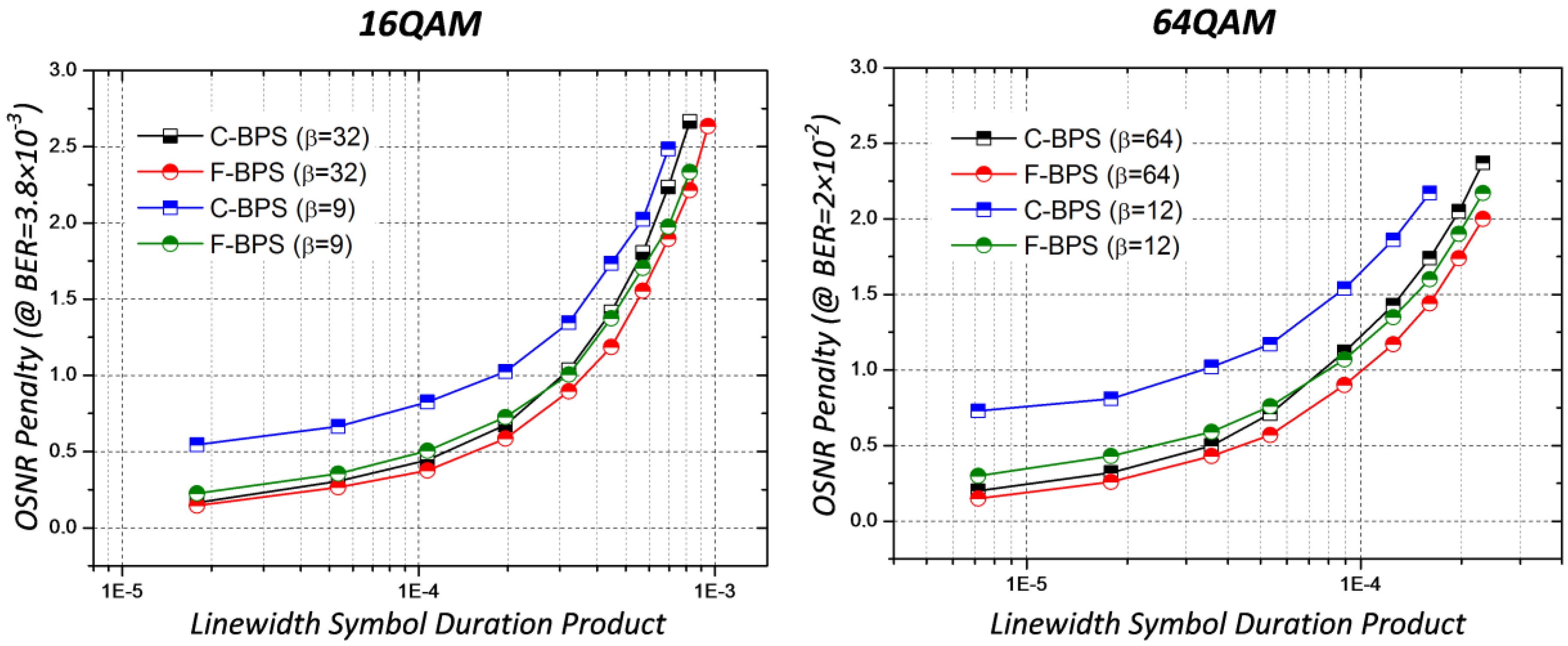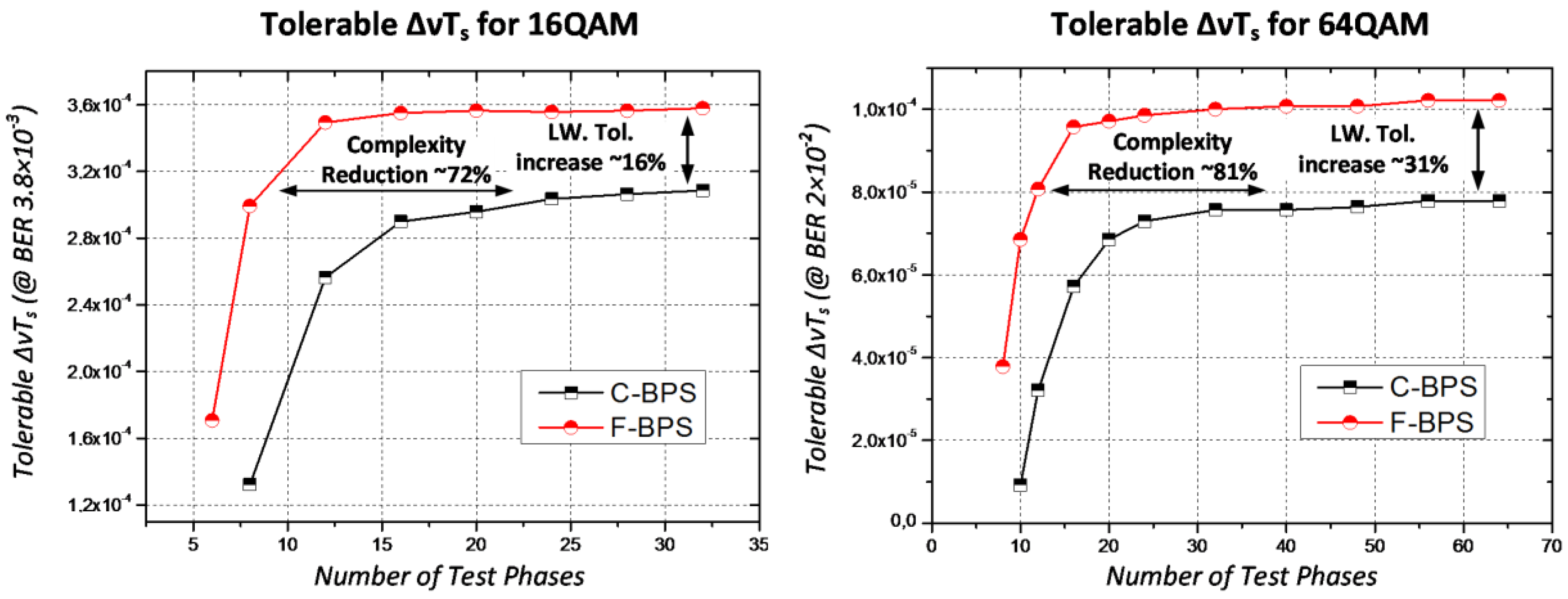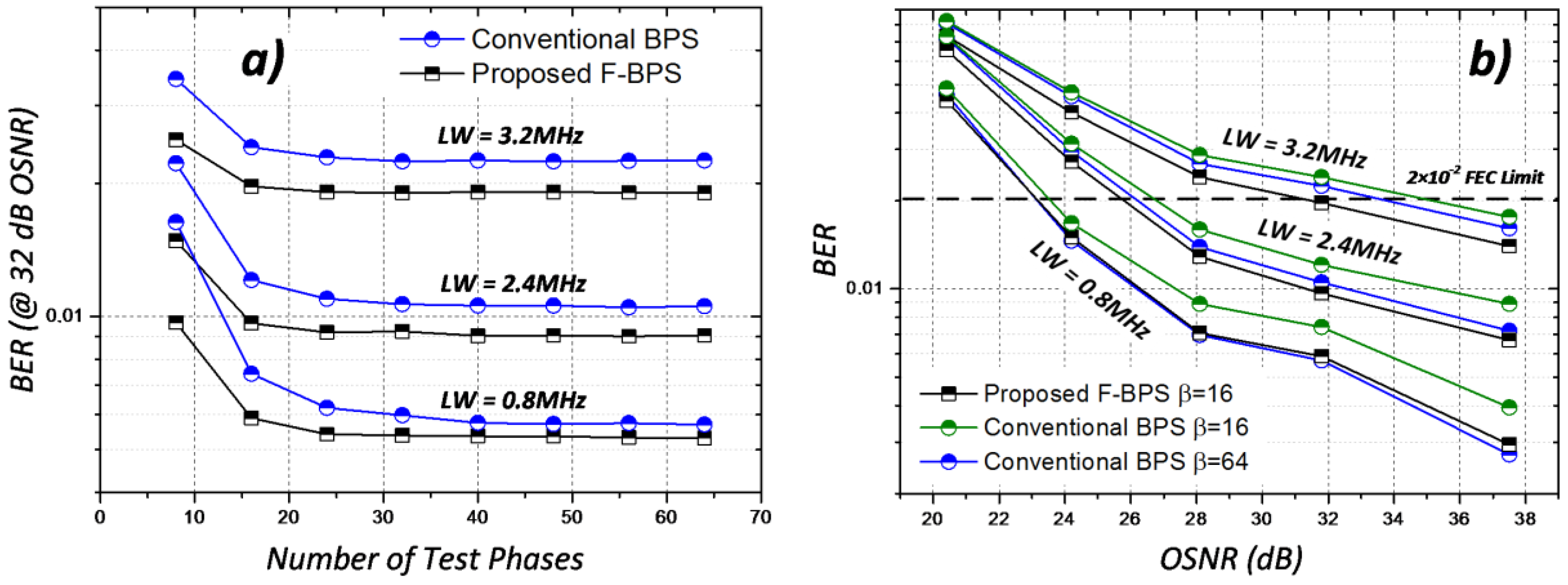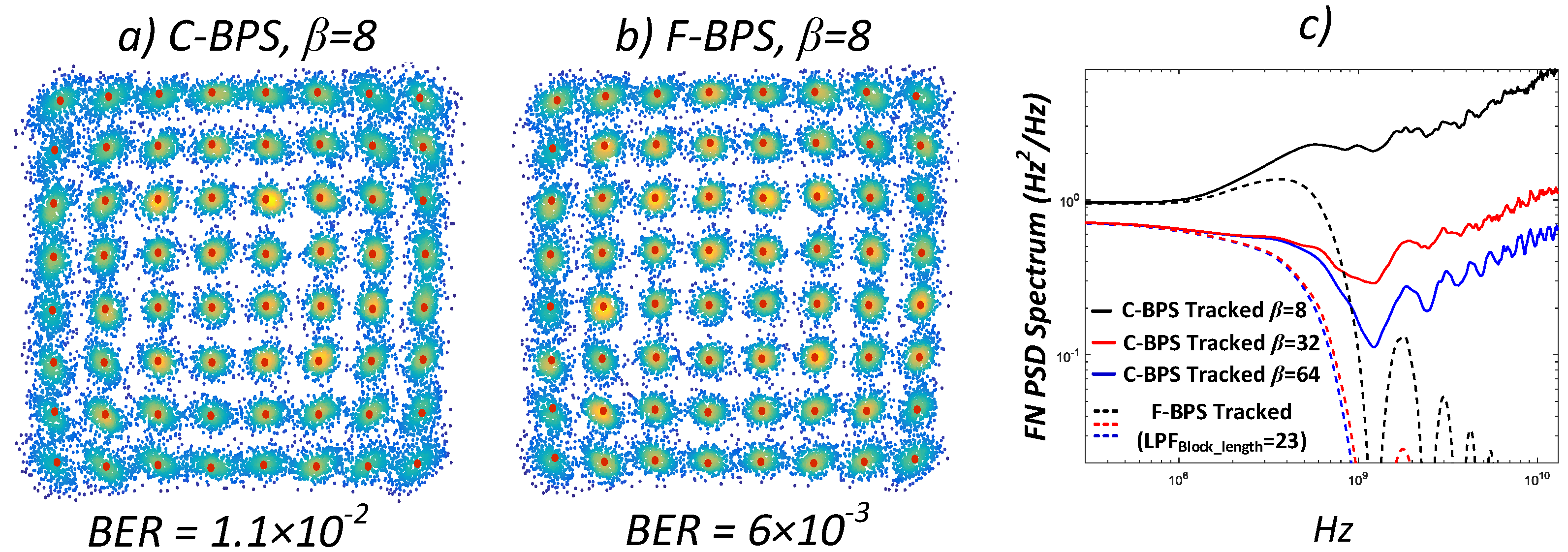Blind Phase Search with Angular Quantization Noise Mitigation for Efficient Carrier Phase Recovery
Abstract
:1. Introduction
2. Principle of the Proposed Angular Quantization Noise Filter in F-BPS
3. Simulation Results
4. Experimental Setup and Results Validation
5. Conclusions
Acknowledgments
Author Contributions
Conflicts of Interest
References
- Viterbi, A. Nonlinear estimation of PSK-modulated carrier phase with application to burst digital transmission. IEEE Trans. Inf. Theory 1983, 29, 543–551. [Google Scholar] [CrossRef]
- Pfau, T.; Hoffman, S.; Noé, R. Hardware-efficient coherent digital receiver concept with feed forward carrier recovery for m-QAM constellations. J. Lightwave Technol. 2009, 27, 989–999. [Google Scholar] [CrossRef]
- Bilal, S.M.; Bosco, G.; Cheng, J.; Lau, A.P.T.; Lu, C. Carrier Phase Estimation through the Rotation Algorithm for 64-QAM Optical Systems. J. Lightwave Technol. 2015, 33, 1766–1773. [Google Scholar] [CrossRef]
- Zhang, F.; Wu, J.; Li, Y.; Xu, K.; Lin, J. Multi-stage feed-forward optical carrier phase estimation based on QPSK partitioning for 64-QAM signals. Opt. Int. J. Light Electron. Opt. 2013, 124, 2557–2560. [Google Scholar] [CrossRef]
- Bilal, S.M.; Fludger, C.R.S.; Curri, V.; Bosco, G. Multistage carrier phase estimation algorithms for phase noise mitigation in 64-quadrature amplitude modulation optical systems. J. Lightwave Technol. 2014, 32, 2973–2980. [Google Scholar] [CrossRef]
- Su, X.; Xi, L.; Tang, X.; Zhang, Z.; Bai, S.; Zhang, W.; Zhang, X. A Multistage CPE Scheme Based on Crossed Constellation Transformation for M-QAM. Photon. Technol. Lett. 2015, 27, 77–80. [Google Scholar]
- Xiang, M.; Fu, S.; Deng, L.; Tang, M.; Shum, P.; Liu, D. Low-complexity feed-forward carrier phase estimation for M-ary QAM based on phase search acceleration by quadratic approximation. Opt. Express 2015, 23, 19142–19153. [Google Scholar] [CrossRef] [PubMed]
- Zhong, K.P.; Ke, J.H.; Gao, Y.; Cartledge, J.C. Linewidth-Tolerant and Low-Complexity Two-Stage Carrier Phase Estimation Based on Modified QPSK Partitioning for Dual-Polarization 16-QAM Systems. J. Lightwave Technol. 2013, 31, 50–57. [Google Scholar] [CrossRef]
- Li, J.; Li, L.; Tao, Z.; Hoshida, T.; Rasmussen, J.C. Laser-linewidth-tolerant feed-forward carrier phase estimator with reduced complexity for QAM. J. Lightwave Technol. 2011, 29, 2358–2364. [Google Scholar] [CrossRef]
- Zhou, X. An improved feed-forward carrier recovery algorithm for coherent receivers with m-QAM modulation format. Photon. Technol. Lett. 2010, 22, 1051–1053. [Google Scholar] [CrossRef]
- Zhou, X.; Lu, C.; Lau, A.P.T.; Long, K. Low-complexity carrier phase recovery for square m-QAM based on S-BPS algorithm. Photon. Technol. Lett. 2014, 26, 1863–1866. [Google Scholar] [CrossRef]
- Navarro, J.R.; Kakkar, A.; Schatz, R.; Pang, X.; Ozolins, O.; Nordwall, F.; Louchet, H.; Popov, S.; Jacobsen, G. High performance and low complexity carrier phase recovery schemes for 64-QAM coherent optical systems. In Proceedings of the Optical Fiber Communication Conference and Exhibition (OFC), Los Angeles, CA, USA, 19–23 March 2017. [Google Scholar]
- Bower, P.; Dedic, I. High speed converters and DSP for 100G and beyond. Opt. Fiber Technol. 2011, 17, 464–471. [Google Scholar] [CrossRef]
- Sun, H.; Wu, K.T.; Thomson, S.; Wu, Y. Novel 16QAM carrier recovery based on blind phase search. In Proceedings of the European Conference and Exhibition on Optical Communications (ECOC), Cannes, France, 22–24 September 2014. [Google Scholar]
- VPIphotonics GmbH, Carnotstrasse 6, DE-10587 Berlin, Germany. Available online: http://www.vpiphotonics.com (accessed on 22 May 2017).
- Navarro, J.R.; Kakkar, A.; Pang, X.; Ozolins, O.; Schatz, R.; Olmedo, M.I.; Jacobsen, G.; Popov, S. Carrier Phase Recovery Algorithms for Coherent Optical Circular mQAM Systems. J. Lightwave Technol. 2016, 34, 2717–2723. [Google Scholar] [CrossRef]
- Kikuchi, K. Characterization of semiconductor-laser phase noise and estimation of bit-error rate performance with low-speed offline digital coherent receivers. Opt. Express 2012, 20, 5291–5302. [Google Scholar] [CrossRef] [PubMed]
- Zan, Z.; Lowery, A.J. Experimental demonstration of a flexible and stable semiconductor laser linewidth emulator. Opt. Express 2010, 18, 13880–13885. [Google Scholar] [CrossRef] [PubMed]







© 2017 by the authors. Licensee MDPI, Basel, Switzerland. This article is an open access article distributed under the terms and conditions of the Creative Commons Attribution (CC BY) license (http://creativecommons.org/licenses/by/4.0/).
Share and Cite
Rodrigo Navarro, J.; Kakkar, A.; Schatz, R.; Pang, X.; Ozolins, O.; Udalcovs, A.; Popov, S.; Jacobsen, G. Blind Phase Search with Angular Quantization Noise Mitigation for Efficient Carrier Phase Recovery. Photonics 2017, 4, 37. https://doi.org/10.3390/photonics4020037
Rodrigo Navarro J, Kakkar A, Schatz R, Pang X, Ozolins O, Udalcovs A, Popov S, Jacobsen G. Blind Phase Search with Angular Quantization Noise Mitigation for Efficient Carrier Phase Recovery. Photonics. 2017; 4(2):37. https://doi.org/10.3390/photonics4020037
Chicago/Turabian StyleRodrigo Navarro, Jaime, Aditya Kakkar, Richard Schatz, Xiaodan Pang, Oskars Ozolins, Aleksejs Udalcovs, Sergei Popov, and Gunnar Jacobsen. 2017. "Blind Phase Search with Angular Quantization Noise Mitigation for Efficient Carrier Phase Recovery" Photonics 4, no. 2: 37. https://doi.org/10.3390/photonics4020037





